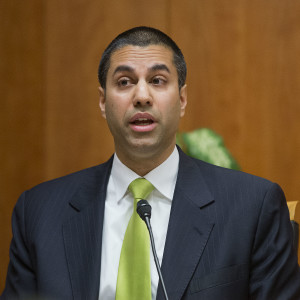The new chairman of the Federal Communications Commission announced steps to increase transparency at the agency Thursday, including releasing the text of all proposals before commissioners vote on them.
Chairman Ajit Pai announced a “pilot program” Thursday to deliver on one of his chief priorities as chairman and one of his top criticisms as a commissioner — the lack of public disclosure on major agency items before they’re voted on.
“Should things go well, my hope is to make it the norm to publicly release, well in advance, the text of all agenda items for monthly commission meetings,” Pai said Thursday. “And my goal is a simple but powerful one: equal access to the administrative process.”
As one of the FCC’s two minority Republican commissioners over the last several years, Pai often lamented the standard agency practice of releasing the text of rules only after commissioners vote on them. He further criticized former Chairman Tom Wheeler for often leaving he and Republican Commissioner Michael O’Rielly in the dark while drafting major agenda items until shortly before votes.
The issue gained prominence in the weeks leading up to FCC’s landmark net neutrality vote in February 2015. Pai, lawmakers, and industry stakeholders urged Wheeler to release the text of the 300-plus page document that brought sweeping changes to the internet landscape, including reclassifying providers as public utilities.
Not only was the Open Internet Order especially significant, they argued, it departed from previous statements by Wheeler to withhold from reclassification, and from the intent of the Notice of Proposed Rulemaking (NPRM). An NPRM is the notice the FCC gives the public when considering a potential new rule. It also seeks public comment on how the rule should be developed.
Wheeler said he was merely following agency precedent and a federal appeals court eventually dismissed the argument and upheld net neutrality.
Pai said the FCC should be held to the same standard as Congress, in that “anyone, anywhere” can read a bill before it’s debated.
“That’s not how things work at the FCC,” Pai said. “The text of a document that the FCC votes on at its monthly meetings is sent to commissioners at least three weeks before the vote, but it isn’t released publicly until after the vote takes place. This is precisely the opposite of transparency.”
The only exception, according to the chairman, are “lobbyists with inside-the-Beltway connections,” who “are typically able to find out what’s in them.”
“But the best that average Americans will get is selective disclosures authorized by the chairman’s office,” he continued, “disclosures designed to paint items in the most favorable light. More often, the public is kept completely in the dark.”
Pai’s trial balloon includes two items which will come up for a vote during the agency’s Feb. 23 open meeting. The first is an NPRM seeking comment on letting TV broadcasters use a new broadcast standard known as ATSC 3.0, or Next Gen TV, which will support mobile television, 3D television, and 4K and higher frame rates. The second is an order giving AM radio stations more flexibility to site FM translators.
“An NPRM and a Report and Order are essentially the beginning and the end of a conversation that an administrative agency has with the American public about regulation,” Pai explained. “One announces a proposal and asks for public input; the other takes stock of that input and announces a decision. I have deliberately chosen one NPRM and one Order for purposes of this test run.”
O’Rielly praised the changes in a statement Thursday.
“This is an idea whose time has finally come,” he said, adding that while it’ll make the job harder, it’s “the right thing to do” for the public, press, and those subject to FCC oversight.
The change is one of a number included in an FCC process reform bill passed unanimously by the House of Representatives last week.
Before being tapped by President Trump to lead the agency, Pai discussed other efforts to increase transparency, including, he said, by “establishing an FCC Dashboard with key performance metrics, we can better enable the public to know what and how we are doing.”

